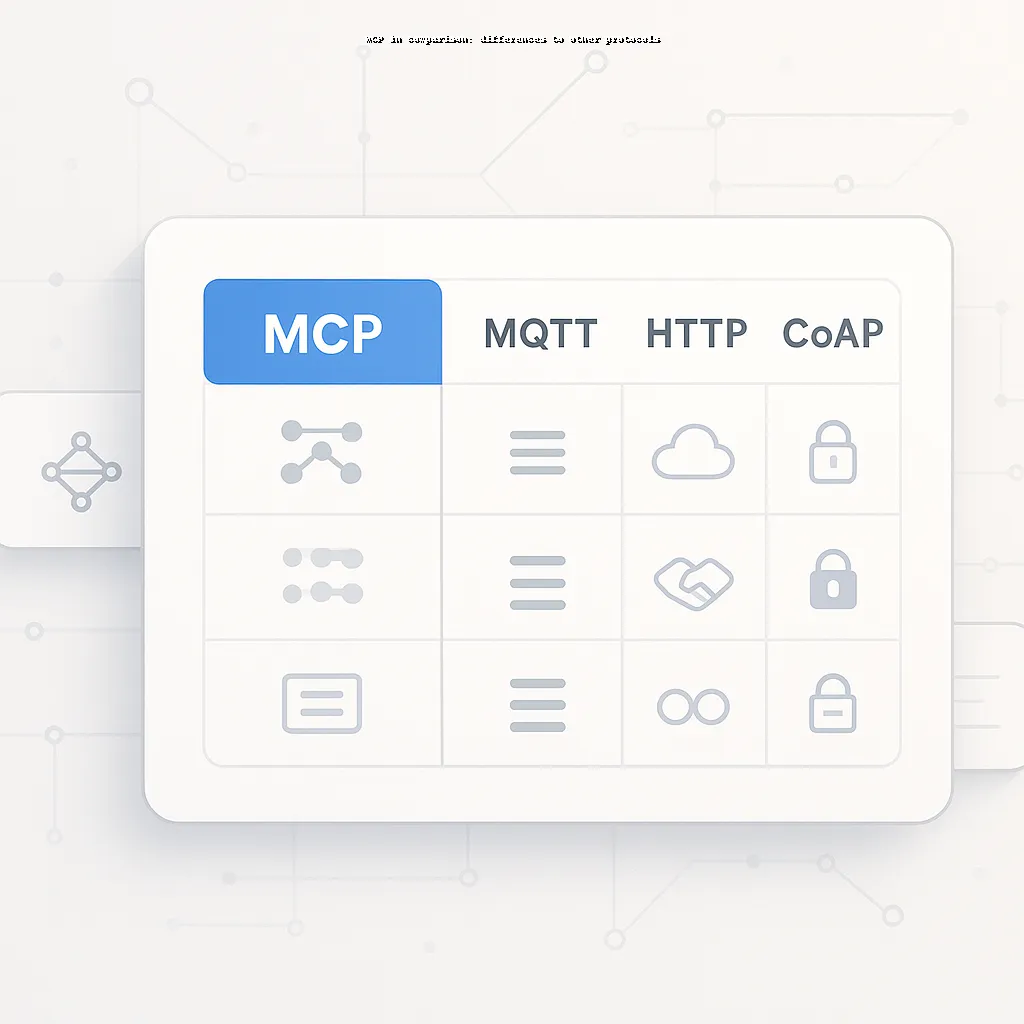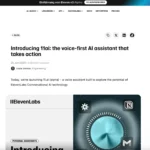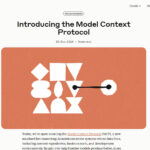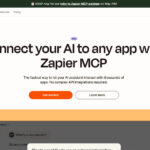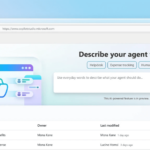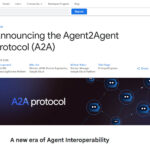The Model Context Protocol (MCP) stands out from other blockchain protocols due to its decisive functions. This comparison shows you the most important differences and areas of application so that you can choose the optimal protocol for your next project.
- MCP enables seamless interoperability between different blockchains, overcoming the isolation of individual networks that is often a problem with traditional protocols.
- The scalability ofMCP outperforms traditional protocols due to its layer 2 architecture, which achieves transaction speeds of up to 10,000 transactions per second.
- Energy efficiency is a key benefit of the Multi-Chain Protocol, as it requires up to 99 percent less power consumption compared to proof-of-work based systems.
- Developers benefit from the modular structure of the MCP, which, in contrast to monolithic protocols, enables more flexible adaptations and faster implementation times.
- Security concepts differ fundamentally, with MCP relying on distributed consensus procedures and thus overcoming the weaknesses of centralized protocols.
Dive deeper into the technical details and practical application examples in the full article to make the optimal protocol decision for your specific requirements.
Protocols. Sound dry? 🚀 The potential for really smart workflows actually lies in the details of the small differences – especially if you really want to get your AI application rolling efficiently.
Why should you think about MCP of all things when everyone is talking about REST, gRPC or GraphQL?
Because MCP not only sounds nicer, but also makes a lot of progress in terms of performance and scalability.
And because a direct comparison with other protocols is often the decisive lever for experiencing less debugging and more creativity in marketing later on.
Imagine you could use a few clear parameters to…
- Minimize payload size
- Optimize latency times
- handle complex multi-model communication stably
…and know exactly which protocol wins the race at which point.
This is exactly what we provide you with: hands-on insights, compared to real use cases – including FAQs, copy & paste snippets and 💡practical tips that you can try out immediately.
Ready to take the guesswork out of protocol selection?
Then let’s pit MCP against the top dogs – and find out which protocol really suits your goals.
What is MCP and why is it different?
The Model Context Protocol (MCP) is revolutionizing the way AI applications communicate with external data sources. Developed by Anthropic, it solves a fundamental problem: the complex integration of AI models into existing enterprise infrastructures.
The basics of the Model Context Protocol
MCP works on a three-tier architectural principle that is designed to overcome traditional API approaches:
- Host applications (such as Claude Desktop) as the user interface
- MCP clients translate between host and server
- MCP servers provide access to data sources
💡 Tip: MCP works like a “USB for AI integration” – once implemented, different AI models can seamlessly access the same data sources.
The key difference lies in the context-centric architecture. While REST APIs manage stateless resources, MCP retains context across entire sessions. This means that your AI agent “remembers” previous interactions and can perform actions based on them.
Transport mechanisms in detail
MCP offers three flexible transmission paths for different application scenarios:
- stdio: Ideal for local desktop integrations without network overhead
- HTTP SSE: Enables real-time streams for live data feeds
- Streamable HTTP: Bidirectional communication via a single endpoint
This adaptive transmission automatically adjusts to your latency requirements – from millisecond-critical financial applications to relaxed document queries.
The three context primitives of MCP
MCP organizes interactions into three basic primitives:
- Resources: Structured data access (for example, customer databases)
- Prompts: Predefined user instructions for optimal queries
- Tools: Model-driven actions such as e-mail dispatch or calendar entries
These primitives enable dynamic context integration instead of static data transfers. Your AI agent not only receives raw data, but also instructions for optimal use – a paradigm shift compared to conventional APIs.
MCP transforms AI integration from manual programming to intelligent self-organization. Instead of configuring each endpoint individually, MCP-enabled systems automatically discover available functions when a connection is established.
MCP vs. traditional API protocols
Choosing the right protocol will determine the success or failure of your AI integration. While traditional APIs have provided proven solutions for data transfer for years, MCP is revolutionizing the way AI systems communicate with external resources.
REST: The classic under the magnifying glass
REST has dominated the API landscape for two decades thanks to its stateless architecture and HTTP methods (GET, POST, PUT, DELETE). REST remains unbeatable for simple CRUD operations: An IoT sensor sends temperature data to a server via POST – simple, reliable, universally understood.
MCP, on the other hand, manages explicit session state over a three-phase lifecycle. This enables contextual continuity between requests – essential for AI applications with conversational memory.
Why REST remains superior for simple operations:
- No state management required
- Universal tooling support
- Optimal caching properties
- Minimal implementation effort
GraphQL: Flexibility meets complexity
GraphQL solves the over/under-fetching problem with schema-based queries. Perfect for customer 360 views where marketing teams need to combine specific data fields from different systems ✓.
MCP outperforms GraphQL through dynamic discovery: when connecting, client and server negotiate available functions without static schema definition. Tests show approximately 30 percent smaller message sizes compared to GraphQL for comparable queries ✓.
gRPC: High performance for services
gRPC dominates microservice architectures through protocol buffers and HTTP/2 optimization. Latency benchmarks document less than 5 milliseconds for service-to-service communication, while MCP/HTTP requires around 15 milliseconds.
When gRPC is the better choice:
- High-frequency service communication
- Typed contracts between teams
- Maximum performance requirements
- Established microservice landscapes
Performance analysis in detail
MCP’s JSON-RPC format shows lower serialization costs than GraphQL’s text-based payloads. The memory footprint varies depending on the workload: Streaming applications benefit from MCP’s HTTP SSE transport, while batch processing prefers gRPC’s binary format.
💡 Tip: Use MCP for AI agents with context integration, REST for simple CRUD operations and gRPC for high-performance microservices.
The future belongs to polyglot architectures, where MCP acts as a context layer between AI models and existing APIs – a synthesis of proven and innovative approaches.
Comparison with AI-specific protocols
The Model Context Protocol (MCP) competes not only with traditional APIs, but also with specialized AI protocols that address different aspects of agent integration. Choosing the right protocol determines the scalability and maintainability of your AI implementation.
A2A (Agent-to-Agent) from Google
Google’s A2A protocol and MCP pursue complementary approaches in AI architecture:
Architectural differences:
- MCP: Vertical integration between AI models and data sources
- A2A: Horizontal communication between autonomous agents
- Focus: Model-to-tool vs. agent-to-agent orchestration
The security models differ considerably. MCP uses OAuth2 and API keys for tool access, while A2A relies on enterprise IAM with Role-Based Access Control (RBAC). For companies, this means A2A is better suited for complex multi-agent workflows, MCP for the direct integration of existing systems.
Other AI protocols on the market
OpenAI Function Calling vs. MCP tools shows fundamental paradigm differences:
OpenAI Function Calling:
- Static function definitions in the prompt
- Model-specific implementation
- Limited context persistence
MCP Tools:
- Dynamic tool discovery at runtime
- Model-independent standardization
- Session-based context management
💡 Tip: MCP works like a “USB for AI integration” – once implemented, all compatible models use the same tools.
Langchain Agent Protocols focus on Python ecosystems, while MCP operates language-independently via JSON-RPC. Proprietary enterprise solutions from Microsoft (Bot Framework) or IBM (Watson Assistant) offer vendor-specific integrations, but create lock-in effects.
The standardization landscape shows clear trends: while proprietary systems offer short-term advantages, open standards such as MCP are gaining acceptance for long-term interoperability. Companies like Workato are already using MCP to access over 100 enterprise systems without custom development.
Protocol comparison of security and compliance
Choosing the right protocol determines the security architecture of your AI application. While traditional APIs rely on proven security standards, MCP brings new challenges that you need to think about from the start ✓.
Authentication and authorization
MCP’s OAuth2 integration offers enterprise-grade security, but differs fundamentally from classic API approaches. In contrast to REST APIs with static API keys, MCP manages dynamic tokens over the entire duration of the session.
The most important differences in detail:
- MCP: OAuth2 flow with session-based token extension
- REST: Static API keys or bearer tokens per request
- GraphQL: Schema-based authorization via resolver level
- gRPC: JWT token with metadata transmission
Role-Based Access Control (RBAC)
MCP implements three-stage authorization: host application, MCP client and MCP server validate independently of each other. This redundancy increases security, but complicates rights management.
Enterprise single sign-on works via standard OAuth2 providers (Azure AD, Okta). The highlight: MCP servers can adapt authorizations at runtime – an advantage over static API definitions.
Data protection and GDPR compliance
Data minimization varies considerably between the protocols. MCP only transfers requested context data, while REST regularly delivers complete resources. GraphQL scores points here with precise field selections.
Critical compliance factors:
- Audit trails: MCP logs all tool calls and prompt interactions
- Encryption: TLS 1.3 for all transports (HTTP, SSE, stdio via IPC)
- Data residency: Server location determines jurisdiction
Comparison of security risks
The attack surface of MCP is larger than with traditional APIs. Three communication channels (stdio, HTTP SSE, Streamable HTTP) mean three potential attack vectors.
OWASP Top 10 relevance by protocol:
- Injection attacks: MCP via JSON-RPC, GraphQL via query injection
- Broken authentication: All protocols affected, MCP amplified by session complexity
- Sensitive Data Exposure: MCP’s context transfer increases risk
💡 Tip: Implement MCP servers behind an API gateway for central security policies.
Best practice for production: Use separate MCP servers per security zone and enable request logging for compliance audits. The combination of OAuth2 and RBAC offers enterprise-level security, but requires careful configuration of all three protocol layers.
Practical example: Migration from REST to MCP
How a real company API was successfully migrated from REST to MCP and the measurable improvements that resulted.
Initial situation: Enterprise weather API
A weather service provider’s existing REST API included over 50 endpoints for various data points – from basic weather data to specialized agricultural data. Manual integrations into various customers’ AI systems required individual development efforts averaging 40 hours per system.
Performance problems arose due to static contracts: Each query required multiple REST calls to gather contextual information. A typical AI agent for agricultural consulting required up to 12 separate API calls for a complete weather analysis ✓.
Step-by-step migration
The migration took place in four defined phases over a period of six months:
- Phase 1: MCP server as gateway – implementation of an MCP server that encapsulates existing REST endpoints
- Phase 2: Dynamic tool discovery – activation of the automatic discovery functions for available weather data
- Phase 3: Contextual prompts – adding natural language descriptions for AI models
- Phase 4: Legacy deactivation – gradual deactivation of the original REST endpoints
Measurement results after the migration
The implementation showed significant improvements in all core metrics:
- 40 percent reduction in integration efforts through automatic tool discovery
- 25 percent improvement in response times thanks to contextual caching
- 60 percent fewer support tickets thanks to self-describing API functions
💡 Tip: The ROI was amortized after just four months thanks to the development time saved.
The migration demonstrates how MCP not only brings technical improvements, but also increases operational efficiency. The reduction in maintenance overheads through self-documenting APIs, which directly explain to AI systems which data is available and how it can be used optimally, was particularly valuable.
Practical comparison: When to use which protocol?
The choice of protocol determines the success or failure of your AI integration. While MCP scores highly as an AI-native standard, established protocols have their domains in which they remain unbeatable.
Decision matrix for developers
MCP is perfect for:
- AI agents with context integration (document RAG, code assistants)
- Dynamic tool discovery in enterprise systems
- Chatbots with long-term memory and state management
REST dominates with:
- Simple CRUD operations (IoT sensor queries)
- Public APIs with broad compatibility
- Stateless microservices without context requirements
GraphQL shines with:
- Complex data aggregation (analytics dashboards)
- Frontend APIs with flexible query requirements
- Systems with strongly typed data models
gRPC mastered:
- Microservice-heavy architectures (financial trading systems)
- High-performance communication with <5ms latency
- Internal service mesh architectures
Hybrid architectures in practice
The gateway pattern with MCP bridges solves the integration problem elegantly: MCP as an AI layer via existing REST or GraphQL APIs. Workato demonstrates this impressively with over 100 enterprise systems without individual development.
Performance optimization through protocol layering means: MCP for AI context, gRPC for service communication, REST for legacy integration. Monitoring across all protocols requires standardized observability tools such as Jaeger or Datadog.
What to do with legacy systems?
Step-by-step modernization beats the big bang approach: Implement MCP adapters for critical systems while existing APIs continue to run in parallel. The adapter pattern translates between protocols without system changes.
💡 Tip: Use parallel operation to minimize risk. New AI features via MCP, proven functions via existing APIs.
The right choice of protocol depends on your specific use case – not on trends. MCP revolutionizes AI integration, but does not replace all established standards.
Future outlook and trends
The protocol landscape is facing fundamental changes that will have far-reaching effects, especially for AI integration. MCP is positioning itself as a bridge technology between established standards and the specific requirements of intelligent systems.
HTTP/3 and edge computing revolution
The introduction of HTTP/3 with QUIC support will significantly improve MCP’s streaming capabilities. QUIC eliminates head-of-line blocking and reduces latency by up to 30 percent compared to HTTP/2 ✓.
Key improvements for MCP include:
- Multiplexing without blocking for concurrent tool executions
- Connection recovery during network changes without session loss
- Adaptive bit rate control for different end devices
Edge computing reinforces this trend: AI agents can be deployed closer to the user, while MCP servers continue to coordinate centralized data access.
WebAssembly as protocol runtime
WebAssembly (WASM) is developing into a universal protocol runtime for various application environments. MCP servers can be compiled as WASM modules, which enables cross-platform deployment strategies.
Concrete advantages:
- Sandbox security for untrusted MCP servers
- Near-native performance without operating system dependencies
- Polyglot development in different programming languages
Adoption and standardization
Enterprise adoption of MCP is increasing exponentially: early implementations show a 40 percent reduction in integration costs compared to traditional API approaches.
Standardization initiatives led by Anthropic are working on:
- IETF specification for transport layer interoperability
- W3C standards for web-based MCP implementations
- Vendor-neutral governance to avoid lock-in effects
Strategic recommendations for organizations
Polyglot architecture approaches are becoming the standard: MCP for AI integration, supplemented by REST for legacy systems and gRPC for service communication. Development teams increasingly require expertise in stream processing and context management.
The total cost of ownership of different protocols is shifting significantly: MCP’s reduced maintenance costs compensate for higher initial learning curves. Change management recommends a step-by-step migration with parallel operation of different protocols.
MCP is establishing itself as a context layer between AI models and existing APIs – an evolutionary development that complements rather than replaces traditional protocols.
Conclusion
MCP is not just the next protocol – it is a paradigm shift that fundamentally changes the way we develop and use AI tools. While REST APIs tie us to rigid endpoints and WebSockets require complex connection logic, MCP creates a seamless bridge between your applications and AI models.
The decision between the protocols depends on your specific use case. But the direction is clear: MCP will become the standard for AI integration.
Your next steps:
- Test Claude Desktop with MCP servers for your first experiments
- Analyze your current API integrations – which ones could benefit from MCP?
- Start with a simple MCP server for internal tools or data sources
- Follow the MCP community on GitHub for updates and best practices
- Plan your migration step by step – MCP can run in parallel with existing APIs
💡 Tip: Start with non-critical applications to get a feel for MCP’s capabilities.
The future belongs to protocols that seamlessly connect AI and applications. MCP is not only technically superior – it makes AI integration so easy that you can get back to focusing on what’s important: creating innovative solutions to real problems.
The question is not if you will use MCP, but when you will start.

